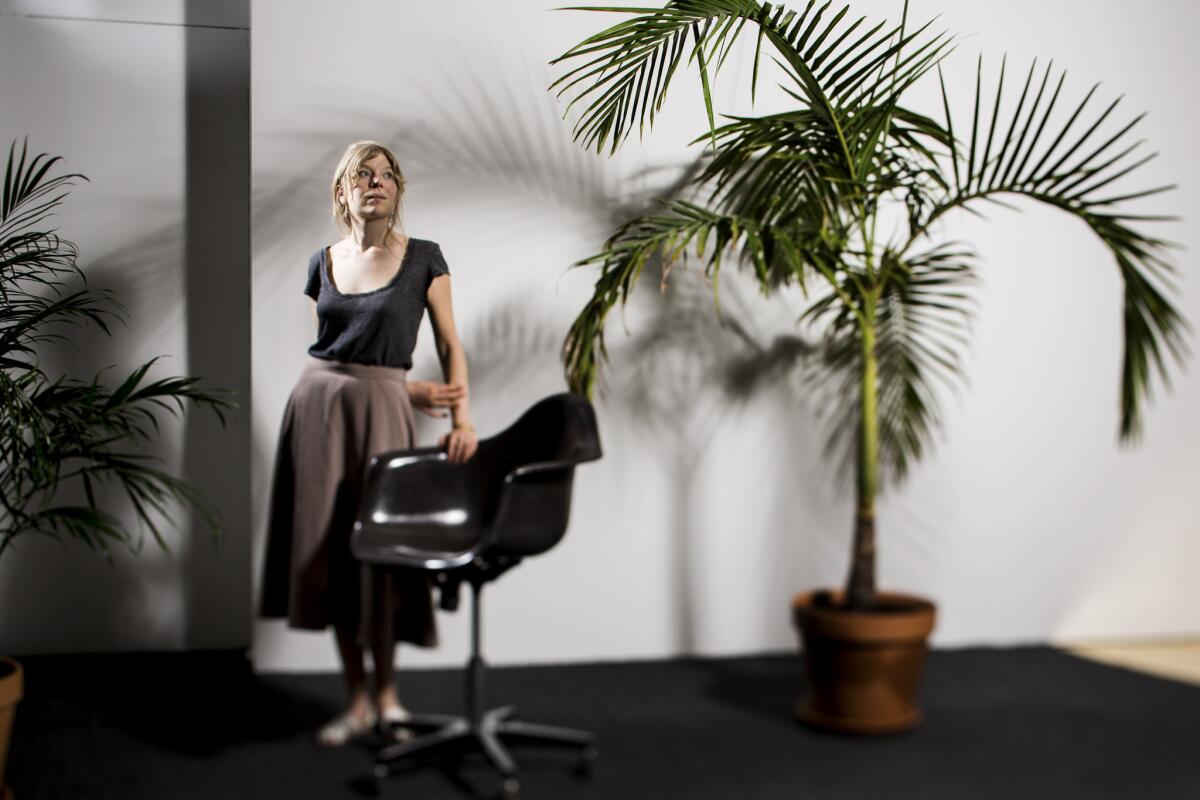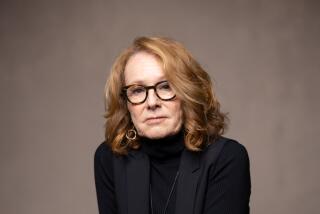Public Fiction is collectively in Hammer Museum’s ‘Made in L.A.’

The room is small and spare, with stark white walls, a 1960s office desk and gray carpeting so new the sour scent of freshly applied glue permeates the air. A leafy palm tree sprouts from one corner.
Soon this quiet, nondescript room — part of the Hammer Museum’s “Made in L.A. 2014” biennial opening Sunday — will be filled with stories curated by the Highland Park art space Public Fiction.
One of those stories: an ambiguous assemblage by artist Eric Wesley of small, metallic tiles, like shiny, oversized Legos, whose ultimate form remains a mystery until the very end of the viewing. An unnamed narrator gives an introduction to the room itself through a piece of fiction by Matthew Brannon. Later in the biennial, the room will be packed with geometric real estate signs by artist Fiona Connor, accompanied by fiction from artist Becket Flannery about a surrealist Occupy movement.
The artists and artist-writers didn’t knowingly work together. Public Fiction’s founder and curator Lauren Mackler asked artists to respond to a description she wrote of the Hammer’s lobby gallery: “The room is a stage, sure,” she wrote, “but not a clean slate … There is lots of open space to be filled, or not.”
Six artists and six writers or artist-writers will take turns, two at a time, filling the gallery with visual art or performances, while the fiction is made available in pamphlets outside the space. These “episodes,” as Mackler calls them, will turn over every two weeks throughout the Hammer’s biennial. The disconnected chapters of fiction will later be bound into a novel.
Public Fiction is just one of the 35 collectives and individual artists chosen by the Hammer’s “Made in L.A. 2014” co-curators Connie Butler and Michael Ned Holte to present new and recent paintings, sculptures, installations, videos, photography and performances for the biennial. “Made in L.A. 2014” is the first exhibition at the Hammer to take over every one of the museum’s galleries at once, even the permanent collection space, as well as nooks and crannies in the courtyard, on terraces and in other public areas.
The room from Public Fiction is an example of the growing trend toward artist-run spaces and independent art collectives in the city — something Butler and Holte wanted to showcase.
Butler, formerly a curator at Los Angeles’ Museum of Contemporary Art, had been living in New York for seven years; when she returned to L.A. in 2013 to take a position as Hammer chief curator, she noticed a particularly cooperative spirit and sense of community among L.A. artists. While visiting hundreds of artists’ studios with Holte to come up with the 2014 biennial lineup, the curators had lengthy discussions with artists about how they saw their city’s art scene. Collectivity and collaboration were recurring themes.
“It’s something you see internationally,” Butler says. “But we felt that right here, right now, there’s a certain vitality around these groups in L.A. and that this was something that really characterized the L.A. scene at this moment.”
Public Fiction perfectly embodies that spirit, says Butler, who learned about the art space from her USC students about a year and a half ago. “Young curatorial students and artists were looking a lot at Lauren’s program,” Butler says. “It was clear that if we wanted to represent the most interesting things happening in the contemporary realm in the city, she’s a nexus, there’s a locus there of activity and thinking.”
Since 2010, when it opened, Public Fiction has become a social hub and a destination for creative experimentation for dozens of emerging and well-known artists. Sculptor Liz Glynn, conceptual artist William Leavitt and photographer Barbara Kasten have all shown there. Mackler chooses a topic for each show, then invites artists to create work — visual artworks, lectures, performances, screenings, musical acts, fiction, anything goes — around that idea. Each exhibition’s three-month run culminates in a printed journal Mackler creates, featuring new works inspired by the show.
In addition to the work of individuals, “Made in L.A. 2014” features more artist teams and collaborations than were included in the inaugural 2012 biennial. The same goes for micro-institutions like Public Fiction, which are putting on their own group exhibitions within the larger biennial. In this way, these outside institutions and their curators — the others are Alice Könitz’s Los Angeles Museum of Art, KChung TV, and James Kidd Dance Studio — are being exhibited like individual artists. By juxtaposing the groups against one another, the overall biennial, say its curators, is also about curating.
Könitz, for example, graduated from CalArts in 1999 and so brings something of a historical perspective to her group show at “Made in L.A.,” which is largely sculptural. Mackler, who’s newer to L.A., grew up in Paris, Hong Kong, Singapore, Australia, Brussels and Washington, D.C., with parents who were foreign correspondents. She studied studio art in college at New York University, but quickly became more interested in curating the works of her peers at empty storefronts and performance venues around New York. She enrolled in the Rhode Island School of Design for an MFA in graphic design because she felt it would give her additional skills that would help her distribute the work of other artists. Her Hammer show is more print- and performance-based.
In 2010, Mackler moved to L.A. specifically to create Public Fiction. She knew almost no one, but felt the natural landscape of the city lent itself to her vision.
“I was very struck by space in L.A. — open spaces, empty spaces, storefronts,” she says. “There was this air of ability or freedom, the sense that’s nobody’s watching. And the sort of manifest destiny impulse everyone describes, the sense of ambition from the unknown, it worked on me.”
Night Gallery founder Davida Nemeroff, a new friend, drove Mackler around Highland Park to search for available spaces for Public Fiction; eventually Mackler decided on the unmarked, industrial-looking brick building on Avenue 50 that her project now inhabits.
Public Fiction’s debut show, “Public Records,” transformed the space into a “record store” and explored music as well as archives and collecting. For “The Free Church,” its second show, artists turned the space into their version of a house of worship, and featured performances and art elements. For that show, former MOCA Director Jeffrey Deitch, to whom Mackler had sent an email of introduction and with whom she ultimately became friendly, donated the money to fund Public Fiction’s first print journal.
Mackler has staged seven exhibition series at the Highland Park space so far. Several artists featured in the Hammer’s last biennial, such as Scott Benzel and Alex Olson, are Public Fiction alums. As are many of this year’s participants, including Emily Mast, Jibade-Khalil Huffman and Lucky Dragons’ Sarah Rara.
Public Fiction is no stranger to setting up shop within other institutions. Just last month, it was part of the art fair Frieze New York, collaborating with conceptual artist Allen Ruppersberg on a re-staging of his 1971 project, “Al’s Grand Hotel.” In 2012 it participated in MOCA’s offsite show, the Mike D-curated “Transmission LA: AV Club” at the Geffen Contemporary.
“I’ve always been interested in how Public Fiction could live within institutions,” Mackler says. “The idea of being an exhibition within an exhibition is really timely for us.”
The Hammer show, however — called “A Public Fiction” and co-curated with art writer and curator Sarah Lehrer-Graiwer — is the first time Public Fiction has put on a two-pronged exhibition, taking place simultaneously at the museum and at its Highland Park location.
The Highland Park storefront will show the exhibition “Tragedy + Time,” featuring a stand-up-comedy-style stage backed by a red curtain, to which six artists and six comedians will respond however they see fit. What’s created there will also be represented at the Hammer biennial, on a much smaller stage outside the museum store.
“The first ‘Tragedy + Time’ artist, Amanda Ross-Ho, is doing a video that’s a satellite image of what’s on stage at Highland Park,” says Lehrer-Graiwer. “The second artist, Neal Bashor, will show a small, abstract wood sculpture [at the Hammer] related to his bigger sculpture onstage at Public Fiction.”
Some other Public Fiction pairings at the Hammer include a zebra-like sculpture by Margaret Lee presented with fiction by “Girls” TV writer Sarah Heyward; and a 16-millimeter film that’s a mix of live-action, animation and a custom “scent” by artist Mateo Tannatt paired with humorous fiction by artist-writer Benjamin Weissman that’s about the porn industry.
Viewers can follow the exhibition as it unfolds on a Public Fiction Tumblr page featuring new images each week. After “some fundraising,” Mackler will create a bound book with expanded material from both shows.
If all of this seems confusing, well, that’s part of the point, says Mackler.
“Complicated is inherent to Public Fiction — it’s multi-layered and collaborative and it involves a lot of people, writers, artists, curators,” says Mackler. “This joining of voices ends up asking a lot from the viewer and the reader; but if you invest the time, it’s very fulfilling because of the relationships it creates — it adds to the L.A. art landscape on a very human level.”
------------
‘Made in L.A.’
Where: Hammer Museum, 10899 Wilshire Blvd., Los Angeles
When: Sunday through Sept. 7. Closed Mondays.
Tickets: Free
Information: (310) 443-7000, https://www.hammer.ucla.edu
More to Read
The biggest entertainment stories
Get our big stories about Hollywood, film, television, music, arts, culture and more right in your inbox as soon as they publish.
You may occasionally receive promotional content from the Los Angeles Times.











